Stereo Alpen
The Stereo Alpen (ステレオアルペン) is a Japanese stereo camera taking pairs of 23×24mm exposures on 35mm film, made by Hachiyō Kōgaku Kōgyō (the maker of the Alpenflex) in 1954–5. It was the first such camera made in Japan.
Contents
Description
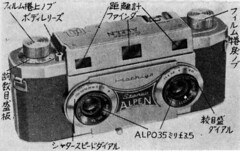 
|
| Stereo Alpen, Alpo 3.5cm f/3.5 lenses no.295017 and 295018. Pictures in Shashin Kōgyō October 1954. (Image rights) |
The Stereo Alpen is much inspired by the Revere Stereo 33. It has an all-metal die-cast body[1] and a separate rangefinder and viewfinder. The viewfinder is in the middle of the top housing, has 0.4× magnification and a built-in bubble level.[2] The rangefinder has rectangular windows on either side and an eyepiece offset to the left, as seen by the photographer; it shows 1.3× magnification.[3] There is an accessory shoe above the rangefinder eyepiece.
The distance setting wheel, graduated from 3ft to infinity, is on the opposite side and falls under the photographer's right thumb.[4] It adjusts both the rangefinder and the focusing distance by moving the film plane back and forth, as on the Mamiya Six: the inner plate with the exposure frames and guide rails is sustained at both ends and is displaced by a cam and lever mechanism.[5]
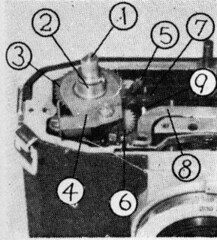
|
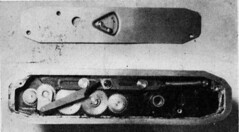
|
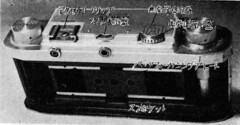
| |
| Advance mechanism under the top and bottom covers, and exposure chamber with the mobile film plane and the sprocket wheel at the middle. (Image rights) | |
The film advance knob is at the right end of the top plate, and its base is surrounded by an exposure counter. The shutter is cocked by the film advance mechanism in a single movement. The camera can take 29 stereo pairs on a 36-exposure film roll.[6] The left-hand exposure chamber has a notch to recognize the frames easily once exposed. The release button is at its usual location next to the advance knob; it has double exposure prevention and contains a thread for a cable release. The rewind knob is at the opposite end, and the rewind unlock lever is under the bottom plate. There is a film reminder disc above the viewfinder eyepiece. The back is removable for film loading, and is closed by a latch on the right. There is a tripod thread under the camera, offset to the left.
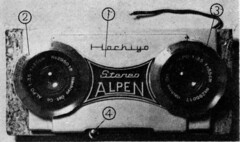 
|
| Lens plate and shutter coupling mechanism, from the front and from behind. (Image rights) |
The lenses are four-element Alpo 3.5cm f/3.5, separated by 70mm.[7] The two leaf-shutter units are placed behind the lenses — one source from the Hachiyō company said that this would allow future developments with interchangeable lenses; it is not known how seriously this was studied.[8] The shutters and diaphragms are fully coupled. The speed ring surrounds the right-hand lens, and has B, 1–200 settings; the aperture ring surrounds the other lens and goes from 3.5 to 22. The company name Hachiyo and the model name Stereo ALPEN are inscribed between the two lenses. There is a lever below the shutter casing, used to wind the shutter by hand for voluntary double exposures, or to take regular (two-dimensional) photographs by alternatively hiding the two lenses.
The dimensions are 170×78×56mm and the weight is 850g.[9] The die-cast body, rangefinder stand, front plate and back are made of aluminium to save weight.[10]
Viewer and frames
 
|
| Stereo Alpen viewer and stereo frame. (Image rights) |
Hachiyō designed specific stereo frames and a stereo viewer for the Stereo Alpen. This viewer appears only as a drawing in Shashin Kōgyō October 1954, because it was not yet ready.[11] It may be that this viewer was never actually produced and remained a project only.
The design was obviously inspired from the Revere Stereo 22 viewer (for the Revere Stereo 33 camera). According to the description, the device is made of plastic and contains batteries and a bulb to illuminate the pictures from behind. It has a pair of 35mm lenses, focused from +3D to -3D by knobs on either side, and the eye interval is adjustable from 60mm to 70mm by a lever at the top. The name Stereo ALPEN is displayed above the battery compartment.

|
| Announce of the Stereo Alpen in Shashin Kōgyō September 1954. (Image rights) |
Commercial life
The Stereo Alpen was featured in Japanese magazines from July 1954, and was advertised from January to October 1955.[12] The February 1955 advertisement in Asahi Camera does not give any price, and says that the camera was the "first Japanese stereo camera".[13] This assertion is not true: other models were made decades earlier, such as the Tokioscope or Sun Stereo. However the Stereo Alpen was indeed the first of a short wave of Japanese stereo cameras, and it was the one with most features. One source says that it was priced at ¥35,000, a hefty sum, to compare with the ¥2,000 of the contemporary Stereo Hit.[14]
Actual examples
Pictures of at least three examples of the Stereo Alpen have been observed so far. All the lens numbers are in the 295xxx range; the "29" prefix probably stands for Shōwa year 29, i.e. 1954.
Early prototype, used for evaluation
The camera pictured in the original documents has lens no.295017 (left) and 295018 (right). The covers and front plate have an all chrome finish. There is a separate plate covering the top part of the camera with the rangefinder mechanism; it has the name Stereo ALPEN engraved in the middle, and the serial number in front of the accessory shoe.
The right-hand shutter was perhaps re-used from another camera, or taken from a production line of shutters for the Alpenflex: the inner pictures show that its rear side has a plate with the company name HACHIYO OPT. CO. and an aperture scale graduated from 3.5 to 22. The left-hand shutter has an internal cable for flash synchronization, going to the accessory shoe which has an isolated flash contact.
That very camera was sent for evaluation in 1954 to H. C. McKay in USA, who planned to distribute the Stereo Alpen there.[15] Its original serial number was 195405, as appears on a factory photograph — it was certainly the fifth camera made in 1954. It initially had thin vertical mills running all along the advance and rewind knobs — visible on the original pictures reproduced above. It appears that the camera was damaged, and its top plate was replaced with serial number 195407, whereas the advance and rewind knobs were substituted for others, with a row of heavy knurls. The rest of the camera was unchanged, and the lens numbers remained the same. The camera in its present condition is pictured below, from the collection of the late H. C. McKay.[16]
Black finished prototype
The second example has black-finished covers and front plate.[17] The advance and rewind knobs have three rows of fine vertical mills. There is a synch socket buried next to the rewind knob, and the flash contact inside the accessory shoe was perhaps abandoned. The lens numbers are faintly legible as 295065 (left) and 295051 (right).[18] It seems that the top cover has no marking, and the name Hachiyo at the front is not paint-filled.
Later camera, one-piece top cover
The third example has a chrome top cover, apparently made of a single part with no separate cover for the rangefinder mechanism.[19] There is a crescent-shaped window at the top in front of the rangefinder wheel, to display the distance scale, with depth-of-field indications. The advance and rewind knobs are similar to those of the black example, and the synch socket is placed the same.
The front plate is black finished, and the name Hachiyo is paint filled, surely in white. The letter "S" in the Stereo ALPEN marking at the front is not shaped the same as on the previous cameras. The name Stereo Alpen is repeated on the top cover, but the marking differs from that of the early camera. The lens numbers are 295108 (left) and perhaps 295090 (right).
Total production
Despite the long interval between the first announce in July 1954 and the last advertisement in October 1955, the lens numbers seem to indicate that very few Stereo Alpen were produced, maybe around fifty. An article in Shashin Kōgyō October 1957 on the Owla Stereo says that the Stereo Alpen was "tried but disappeared with almost no serial production".[20]
Notes
- ↑ Die-cast body: Yamanaka, p.298 of Shashin Kōgyō October 1954.
- ↑ 0.4× magnification, built-in bubble level: Yamanaka, p.300 of Shashin Kōgyō October 1954.
- ↑ 1.3× magnification: Yamanaka, p.300 of Shashin Kōgyō October 1954.
- ↑ 3ft to infinity: Yamanaka, p.300 of Shashin Kōgyō October 1954.
- ↑ Yamanaka, p.300 of Shashin Kōgyō October 1954.
- ↑ Yamanaka, p.299 of Shashin Kōgyō October 1954.
- ↑ Four elements, 70mm separation: advertisement reproduced in Kokusan kamera no rekishi, p.118, column in Shashin Kōgyō September 1954, p.202, and Yamanaka, pp.298–9 of Shashin Kōgyō October 1954.
- ↑ Yamanaka, p.299 of Shashin Kōgyō October 1954.
- ↑ Yamanaka, p.298 of Shashin Kōgyō October 1954. The column in Shashin Kōgyō September 1954, p.202, says 170×80×55mm and 1kg.
- ↑ Yamanaka, p.301 of Shashin Kōgyō October 1954.
- ↑ Yamanaka, p.301 of Shashin Kōgyō October 1954.
- ↑ Kokusan kamera no rekishi, p.346.
- ↑ Advertisement reproduced in Kokusan kamera no rekishi, p.118.
- ↑ ¥35,000: see this page of the JCII collection. The articles in Shashin Kōgyō September and October 1954 do not mention the price.
- ↑ From the personal papers and collection of Herbert C. McKay.
- ↑ Photographs, at the McKay Collection
- ↑ Example pictured in Lewis, p.86, and in this page of the JCII collection. The only available picture may give the impression that the rangefinder windows are obturated, and that the top cover is protected by some sort of coating, but this is probably not true.
- ↑ The catalogue from the 1984 exhibit at George Eastman House "The Evolution of the Japanese Camera" shows a picture on page 44 of the black model with these lens numbers. It was on loan from the JCII.
- ↑ Example pictured in Sugiyama, item 6031, and in Shima, p.22 of Kurashikku Kamera Senka no.27.
- ↑ Kitano, p.375 of Shashin Kōgyō October 1957: 試作されたしかし殆ど量産されずに立消えとなっている.
Bibliography
Original documents
- Kitano Kunio (北野邦雄). "Atarashii kamera: Aura Sutereo" (新しいカメラ・アウラステレオ, New cameras: Owla Stereo). In Shashin Kōgyō no.66 (October 1957). Pp.374–5. (Briefly mentions the Stereo Alpen.)
- Shashin Kōgyō no.28 (September 1954). "Shinseihin shōkai: Sutereo Arupen" (新製品紹介・ステレオ・アルペン, New product presentation: Stereo Alpen). P.202.
- Yamanaka Hideaki (山中英明), from the company Hachiyō Kōgaku Kōgyō. "Sutereo Arupen" (ステレオ・アルペン, Stereo Alpen). In Shashin Kōgyō no.29 (October 1954). Pp.298–301.
Recent sources
- Asahi Camera (アサヒカメラ) editorial staff. Shōwa 10–40nen kōkoku ni miru kokusan kamera no rekishi (昭和10–40年広告にみる国産カメラの歴史, Japanese camera history as seen in advertisements, 1935–1965). Tokyo: Asahi Shinbunsha, 1994. ISBN 4-02-330312-7. Item 380.
- Lewis, Gordon, ed. The History of the Japanese Camera. Rochester, N.Y.: George Eastman House, International Museum of Photography & Film, 1991. ISBN 0-935398-17-1 (paper), 0-935398-16-3 (hard). P.86.
- Shima Kazuya (島和也). "Sutereo kamera onparēdo" (ステレオカメラオンパレード, Stereo cameras on parade). Kamera Rebyū: Kurashikku Kamera Senka (カメラレビュー クラシックカメラ専科) / Camera Review: All about Historical Cameras no.27, December 1993. No ISBN number. Stereo World (ステレオワールド). Pp.21–5.
- Sugiyama, Kōichi (杉山浩一); Naoi, Hiroaki (直井浩明); Bullock, John R. The Collector's Guide to Japanese Cameras. 国産カメラ図鑑 (Kokusan kamera zukan). Tokyo: Asahi Sonorama, 1985. ISBN 4-257-03187-5. Item 6031.
Links
In Japanese:
